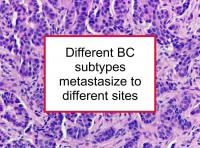A new study has reported that different breast cancer subtypes are prone to metastasize to different sites of the body. The authors hypothesized that the protein expression pattern of the primary tumor influences the first site of metastasis. The study included 2,032 Finnish patients diagnosed with breast cancer in 1991 or 1992.
The authors reviewed the hospital medical records for each case and obtained primary tumor tissue samples. A total of 234 of the patients developed distant metastases (in a total of 321 sites) after a median period of 2.7 years after their initial breast cancer diagnoses.
Primary tumor microarray cores were analyzed for 17 proteins (using immunohistochemistry) and for HER2/neu oncoprotein (using chromogenic in situ hybridization). A total of 3,886 cores were analyzed. The associations of the proteins and HER2 with the first site of metastasis were examined.
The tumors were classified into luminal A, luminal B, HER2-positive (HER2+), basal-like or non-expressor subtypes. These are molecular phenotypes, as determined by gene expression profiling. Luminal A tumors are strongly estrogen receptor positive (ER+) and progesterone receptor positive (PR+) and not HER2-positive, with low tumor grade and low proliferation.
Luminal B are weak to moderate ER+/PR+ and can be HER2- or HER2+. Luminal B tumors may have low tumor grade, but have higher proliferation and DNA instability than luminal A tumors. ER+/PR- and ER-/PR+ tumors are normally luminal B. Basal-like tumors are most often triple negative (ER-/PR-/HER2-). However, not all basal-like tumors are triple negative and not all triple negative tumors are basal-like.
Study findings
The authors found that luminal A tumors tended to metastasize first to the bone, HER2+ tumors to the liver and lungs, and basal-like cancers to the liver and brain. Breast cancer that relapsed to the bone was frequently ER+ and seldom HER2+. Tumors with lung metastases were frequently HER2+ and seldom PR+. Breast cancer with first metastases to the brain were seldom ER+/PR+.
The authors conclude that breast tumor subtypes have a tendency to give rise to first distant metastases at specific body sites. Several primary tumor proteins are associated with the homing of circulating breast tumor cells.
